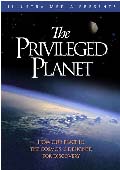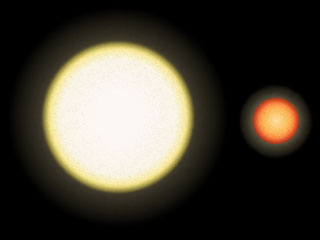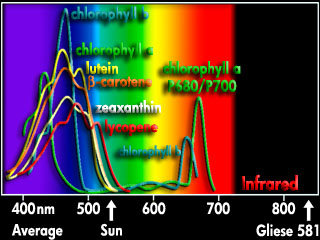Does 'Goldilocks' Planet Gliese 581g Harbor Life?

Introduction
Scientists have discovered over 500 planets outside our own solar system. However, most of these planets are quite unlike the earth, being much larger and much closer to their parent star. At least part of the reason for the difference is due to the ease of detection of larger planets, since they gravitationally disturb their parent star much more than smaller planets. The recent proclamation by astronomer Steven Vogt that "the chances of life on this planet are 100 percent" has the news media buzzing. However, there are some big assumptions that went into this claim, many of which are certainly false.
Parent star
Stars and planets are given names according to the following convention. A star's name usually includes some numbers identifying it. For example, the parent star of the newly discovered planet is called Gliese 581 or Gliese 581a, with the "a" designating the star. Subsequent stars and/or planets are given the next letter, in order of discovery. For example, in a binary system (a system containing two stars orbiting each other), the second star would be given the letter "b". If the planetary system has only one star, the first planet discovered will be given the designation "b". So, we know from the name, Gliese 581g, that it is the sixth discovered planet around the star Gliese 581a. A table containing the characteristics of each of the planets of the Gliese 581a system are shown below:
| Planet | Period (days) | K (ms-1) |
m sin i (M�) | a (AU) | Mean Anomalya (°) | FAPS |
|---|---|---|---|---|---|---|
| b | 5.36841 (0.00026) | 12.45 (0.21) | 15.6 (0.3) | 0.0406163 (1.3e-6) | 276.1 (4.9) | 6.8E-306 |
| c | 12.9191 (0.0058) | 3.30 (0.19) | 5.6 (0.3) | 0.072993 (2.2e-5) | 33 (19) | 2.3E-33 |
| d | 66.87 (0.13) | 1.91 (0.22) | 5.6 (0.6) | 0.21847 (2.8e-4) | 56 (27) | 0.0000025 |
| e | 3.14867 (0.00039) | 1.66 (0.19) | 1.7 (0.2) | 0.0284533 (2.3e-6) | 267 (40) | 1.9E-08 |
| f | 433 (13) | 1.30 (0.22) | 7.0 (1.2) | 0.758 (0.015) | 118 (68) | 0.000095 |
| g | 36.562 (0.052) | 1.29 (0.19) | 3.1 (0.4) | 0.14601 (1.4e-4) | 271 (48) | 0.0000027 |
Solar emission
The star itself is rather typical of stars in our galaxy, being a red dwarf, about one third the mass of our star the Sun. The fact that the star is much smaller than our star has some profound implications regarding possible life on the planet. First, the surface temperature of the star is less than a third that of the Sun.2 This means that the habitable (or Goldilocks) zone is much closer to the star. The small mass and lower temperature means that the star is emitting energy primarily in the longer wavelengths (lower energy). This is why the star appears red (mean radiance at 830 nm), instead of yellow, like the Sun (mean radiance at 530 nm). Light emitted primarily at the red end of the visible spectrum will profoundly affect possible photosynthesis on nearby planets. Photosynthetic pigments of organisms on earth absorb energy in the higher energy wavelengths associated with visible light, that is, violet or blue, and to a lesser extent, red. However, if you try to grow your houseplant in red light it will promptly die.
Although chlorophylls absorb energy down to 700 nm, a dwarf star with mean radiance at 830 nm will find most of its emission unusable by photosynthetic organisms. Is it possible that organisms that evolve around red dwarfs will develop photosynthetic pigments that absorb energy from the red/infrared end of the visible spectrum? Although it is possible, the physics of electromagnetic radiation severely limits the efficiency of such a pigment, since the reduced energy of such light might be insufficient to excite electrons to a higher energy state (during the light reaction phase of photosynthesis). In addition to the photosynthesis problem, red dwarfs suffer from frequent solar flares, which would periodically dowse the planet with high levels of radiation.
Metallicity
By solar standards, Gliese 581a is relatively "metal-poor." In astronomical terms, "metal" does not necessarily refer to things like iron, but to any elements heavier than helium. Initially, during the beginning of the Big Bang, only hydrogen was formed. However, there was a period of time (about three minutes) in which the temperature of the universe was high enough to support nuclear fusion. It was during this time that hydrogen was fused to form helium, which made up about 25% of the universe. The heavier elements that make up rocky planets were formed in the cores of generations of stars preceding the current generation. Large stars use their fuel quickly and end catastrophically as a supernovae. The metals produced by these stars are then incorporated into the next generation of planetary systems. Since Gliese 581a is metal-poor compared with the Sun, it is surprising it has at least 5 rocky planets. However, because of its metallicity, it is likely that those planets are less dense than their solar system equivalents.
Planet Gliese 581g
Planet mass
Although declared to be "earth-like," Gliese 581g is actually at least 3 times more massive than earth. This increased mass likely impacts the atmospheric content of the planet. Planets must be of a certain mass in order to retain an atmosphere. For example, Mars has only 10% the mass of the earth. Extensive evidence indicates that it once had a thicker atmosphere and large bodies of water on its surface. However, because of its reduced gravity, it lost nearly all of that atmosphere and water. The earth originally had a much denser atmosphere that was mostly blasted into space during the collision that formed the Moon. Had it not been for this fortuitous collision, the earth would have had an atmosphere similar to Venus (81% the mass of the earth), which has an atmosphere 80 times denser than earth. One of the assumptions of the paper that reports the discovery of Gliese 581g is that the atmosphere is similar to earth's. This assumption is almost certainly wrong, unless the planet experienced a large collision event, similar to earth's, early in its history. With at least 3 times the mass of earth, the planet would likely have an atmosphere much denser than Venus, making life there extremely unlikely. The problem with such a dense atmosphere is the large greenhouse effect, which would raise temperatures dramatically. The fact that Gliese 581a emits light mostly in the red/infrared end of the spectrum would compound the heating effect.
Tidal locking
 Because Gliese
581g orbits close to its star (0.15 AU) and the system is at least 7 billion
years old, the planet is tidally locked with its star. This means that the
planet rotates once every 37 days, the same period over which it revolves around
its star. So, one side of Gliese 581g is perpetually in starlight and the other
in perpetual darkness. This fact results in severe conditions over the majority
of the planet's surface. Assuming an atmosphere similar to earth's, the sunlit
side has an average temperature of 160°F, while the dark side has an average
temperature of -25°F. Only a small strip of the planet, near the edges
between sunlight and darkness would exist at a reasonable temperature for life
to exist. However, in these twilight areas, the amount of solar irradiance would
be very low, compounding the mean radiance wavelength problem, making
photosynthesis all but impossible. The location of the twilight areas of Gliese
581g will not remain stable over time, since all planets tend to wobble around
their axis of rotation, causing these "life zones" to migrate over time.
Because Gliese
581g orbits close to its star (0.15 AU) and the system is at least 7 billion
years old, the planet is tidally locked with its star. This means that the
planet rotates once every 37 days, the same period over which it revolves around
its star. So, one side of Gliese 581g is perpetually in starlight and the other
in perpetual darkness. This fact results in severe conditions over the majority
of the planet's surface. Assuming an atmosphere similar to earth's, the sunlit
side has an average temperature of 160°F, while the dark side has an average
temperature of -25°F. Only a small strip of the planet, near the edges
between sunlight and darkness would exist at a reasonable temperature for life
to exist. However, in these twilight areas, the amount of solar irradiance would
be very low, compounding the mean radiance wavelength problem, making
photosynthesis all but impossible. The location of the twilight areas of Gliese
581g will not remain stable over time, since all planets tend to wobble around
their axis of rotation, causing these "life zones" to migrate over time.
Does Gliese 581g really exist?
Another astronomy team at Geneva Observatory attempted to plug their data on Gliese 581 into computer models and did not see the planet at all, over the random noise seen in the data:
"Simulations on the real data have shown that the probability that such a signal is just produced 'by chance' out of the noise is not negligible, of the order of several percents. Under these conditions we cannot confirm the presence of the announced planet Gliese 581 g."3
Conclusion 
The newly discovered planet Gliese 581g has been advertised as being within the "Goldilocks" zone around its star, leading to the claim, "the chances of life on this planet are 100 percent." The reality of the discovery is that the star is a red dwarf, being much dimmer than our Sun. The nearness of the planet to its star insures that the planet is tidally locked with temperatures on the sunny side being 160°F, while the average temperature on the dark side being -25°F. Only small portions of the planet in the twilight zones are at temperatures conducive to the existence of life. However, the emission spectrum of the star averages in the infrared wavelengths, making photosynthesis problematic. The higher mass of the planet virtually guarantees that its atmospheric pressure is quite high, likely resulting in a runaway greenhouse effect. Rather than being a prime candidate for life, Gliese 581g is likely a hot, sterile world devoid of water. Further investigation of the planet is likely, including possible atmospheric spectra, which will reveal the truth about Gliese 581g, if such a planet really exists at all. One must ask whether the odds of life would remain at 100% if the planet is really just noise in the data. Stay tuned, but don't get in your rocket ship to go for a visit!
Related Resources 
- Kepler 22b: Why it is Almost Certainly NOT Habitable
- The Incredible Design of the Earth and Our Solar System
- Moons Like Earth's Moon are Rare in the Universe
- God of the Gaps - Do All Christian Apologetics Fall Into This Kind of Argument?
 Rare
Earth: Why Complex Life is Uncommon in the Universe by Peter D. Ward and
Donald Brownlee
Rare
Earth: Why Complex Life is Uncommon in the Universe by Peter D. Ward and
Donald Brownlee
A secular book that recognizes the improbable design of the earth. Paleontologist Peter D. Ward and astrobiologist Donald Brownlee examine the unusual characteristics of our galaxy, solar system, star, and Earth and conclude that ET may have no home to go to. Surprisingly, the authors conclude that the amazing "coincidences" are the result of good luck and chance.
 The
Creator and the Cosmos
The
Creator and the Cosmos![]() by Dr.
Hugh Ross
by Dr.
Hugh Ross
A classic book for modern Christian apologetics and science, recently updated with fully one third of the book updated. Dr. Ross presents the latest scientific evidence for intelligent design of our world and an easy to understand introduction to modern cosmology. This is a great book to give agnostics, who have an interest in cosmology and astronomy.
References 
- Vogt, S. S., R. P. Butler, E. J. Rivera, N. Haghighipour, G. W. Henry, and M. H. Williamson. 2010. The Lick-Carnegie Exoplanet Survey: A 3.1M Planet in the Habitable Zone of the Nearby M3V Star Gliese 581. Submitted for publication.
- Gliese 581, Wikipedia.
- Leslie Mullen. 2010. Doubt cast on existence of possibly habitable alien planet, Astrobiology Magazine.
Today's New Reason to Believe
Integrating Science and Faith
- 11/05/2012 12:52 AM
Imperial College Debate on Evidence for God
In spring of 2012, my colleague Kenneth Samples and I spent several days in London, England, speaking in universities, churches, leadership gatherings, and at a conference. God gave us a wonderful opportunity to take RTB’s message of science-faith compatibility overseas. Here I recap my interactions with distinguished professor Lewis Wolpert. **** On May 24, 2012, … Read more
() - 11/01/2012 12:30 AM
Resource Highlight: Creation Day Debates
Earlier this week, guest writer Otis Graf explained how the ejection dynamics of meteoroids from the star Beta Pictoris and the meteoroids’ detection on Earth cannot be reconciled with a young universe—thus challenging young-earth proponent Dr. Jason Lisle’s model for solving the distant starlight problem. RTB’s Hugh Ross and Fazale Rana have debated Dr. Lisle … Read more
() - 10/29/2012 12:44 AM
Alien Particles Challenge a Young-Earth Creation Model
A collimated beam of meteoroids from the star Beta Pictoris has been discovered. However, the ejection dynamics at the star and the meteoroids’ detection on Earth cannot be reconciled with a young universe. This discovery directly challenges two tenets of young-earth proponent Dr. Jason Lisle’s model for solving the distant starlight problem. **** The 1950s … Read more
() - 10/25/2012 12:05 PM
TNRTB Classic: Basking in UV Radiation
On Monday, guest writer and visiting scholar Hugh Henry discussed research into the effects of radiation on the human body. Despite our fear of radiation, it seems that God has designed the human physiology to withstand a reasonable about of exposure. Check out this previous TNRTB from Fazale Rana on how our DNA reacts to … Read more
() - 10/25/2012 12:34 AM
TNRTB Classic: Basking in UV Radiation
On Monday, guest writer and visiting scholar Hugh Henry discussed research into the effects of radiation on the human body. Despite our fear of radiation, it seems that God has designed the human physiology to withstand a reasonable about of exposure. Check out this previous TNRTB from Fazale Rana on how our DNA reacts to … Read more
() - 10/22/2012 12:50 PM
“Deadly” Radiation and God’s Design
A feature article in the August 2012 issue of Scientific American trumpets a scary warning: “Deadly Rays from Clouds—Thunderstorms Give Out Powerful Blasts of X-Rays and Gamma Rays.”1 Headlines are written to grab the reader’s attention—whether or not the article’s content lives up to the hype. At the end of this particular article, the authors … Read more
() - 10/18/2012 12:26 AM
TNRTB Classic: Increased Oxygen
Earth experienced many events that brought it to the brink of becoming a barren wasteland. Two dramatic increases in the atmospheric oxygen content (2.5 and 0.8 billion years ago, respectively) resulted in mile-thick ice sheets that nearly encased the planet. Yet Earth rebounded from all these events, better prepared for the new life that arrived … Read more
() - 10/15/2012 12:17 AM
First Plants Bring Major Climate Change
RTB’s creation model posits that the change in life throughout Earth’s history reflects the work of a divine intelligence transforming a hostile-to-life planet into one capable of supporting humanity. As the environs change, so must the life. Studies of the first plant life on the continents show how the plants altered the land and atmosphere … Read more
() - 10/11/2012 12:36 AM
TNRTB Classic: Junk DNA and the Nucleoskeletal Hypothesis
A few days ago I wrote about the ENCODE project and the new recognition that, at minimum, 80 percent of the human genome consists of functional DNA elements. Despite some skeptics’ complaints that the media, creationists, and intelligent design adherents have misconstrued the ENCODE report, the project’s results stand. The human genome is not a vast … Read more
() - 10/08/2012 12:26 AM
Responding to ENCODE “Skeptics”
Recently, the ENCODE Project Consortium reported that 80 percent of the human genome consists of functional elements, major indicators of design. But some skeptics assert (loudly) that the results of the ENCODE project have been overhyped and misconstrued. In this article, I respond to the most salient points made by the ENCODE “skeptics.” The human … Read more
()
http://www.godandscience.org/apologetics/goldilocks_gliese_581g_planet.html
Last updated October 13, 2010





